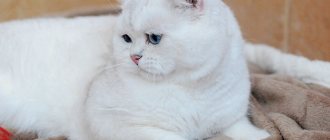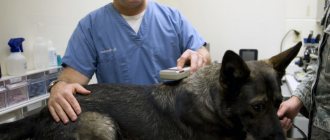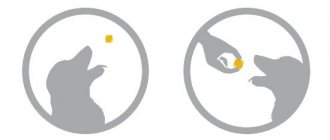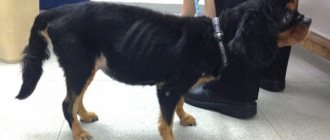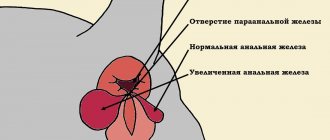All about breeding Shar-Peis
Each breed has original characteristics. Shar Pei breeders have been striving for a long time to restore it to be similar to the original. The manifestation of crossbreeding traits is considered a defect, because when crossing outside the breed, the standard character and exterior are lost.
In addition, no one can find out what the puppies will be like in terms of health and appearance, and the fate of such offspring is not always rosy.
Therefore, it is necessary to approach breeding a pet consciously, assessing its advantages and disadvantages. They can be inherited even after several generations.
A competent approach will allow you not only to avoid poor health, but also to increase your advantages.
Time for mating
The female Shar Pei is ready to breed on certain days of her heat. Usually it lasts 18-21 days, and the optimal time to go to a male dog occurs in the middle - on the 10-15th day. Before and after fertilization does not occur.
Important: Each dog is individual. Sometimes they have hormonal imbalances or body characteristics that lead to changes in the standard timing of estrus and ovulation.
Shar Peis have a recommended breeding age.:
- Bitches – after 20 months;
- Males – after 24 months.
In the RKF system, documents for a litter from parents with pedigrees and clearances from exhibitions can be obtained if the bitch or male is already 15 months old on the date of mating, but not earlier than the second heat.
Several methods will help you find out the optimal timing for mating. The loop is inspected from the first day of estrus. At the moment of readiness (“hunting”) it is swollen and when you lightly press on its acute corner, it increases.
The second way is to press the dog’s croup with your hand, then it will move its tail to the side. The discharge will indicate the onset of the “hunt”; it becomes less intense and practically without blood.
There are also laboratory tests for progesterone. You can learn to examine discharge from a loop during estrus under a regular microscope, but this requires specific knowledge.
Conception and pregnancy
So, after weighing all the pros and cons, you decided to breed your bitch. Notify your club or kennel so that your bitch can be matched with a male that is suitable for her type. Don't forget to take a referral for mating from the club. Agree in advance with the owner of the male dog about the day of the proposed mating and the mating conditions; Write down all the nuances in the “Mating Act”. Conditions may be different - for money (usually the average price of a puppy), for a puppy, etc. and can depend both on the titles, breeding qualities of the dog, on the titles and breeding qualities of your bitch, and on the unreasonable requests of the owner.
It’s a good idea to determine during your dog’s first estrus what day after the start of estrus she is ready for mating. During life, the timing of ovulation sometimes shifts. If two or more bitches live in a house, “synchronization” of sexual cycles often occurs. Conditions of detention, nutrition, physical or nervous stress, including frequent exhibitions, long journeys affect all functions of the body, especially reproductive ones. Shar Pei bitches can have their first heat at the age of either six or fifteen months. It's very individual. Typically, the sexual cycle in dogs lasts 5-9 months. Shar Pei bitches can be bred according to the rules of the RKF no earlier than 15 months.
The emptying period usually lasts 2-3 weeks. During estrus, the loop swells and bleeding appears. The dog becomes restless, disobedient, and flirts with male dogs on the street. Of course, at the first signs of heat, you should only walk your dog on a leash, and do not trust children to walk. Under no circumstances leave your dog on your summer cottage, even if it is surrounded by a seemingly secure fence. The period of sexual heat (estrus) lasts about a week (sometimes 3-12 days). The bitch is ready for mating: the loop is slightly reduced in volume, but becomes softer. The discharge becomes significantly lighter and acquires a creamy tint. When you stroke the back at the base of the tail, the dog freezes and moves the tail to the side; when you touch the perineum, it pulls the loop up. Ovulation most often occurs on days 1-3 from the start of heat (sometimes on days 5-7 or even 2 days before it). Typically, mature follicles ovulate within 24 hours. However, eggs become capable of fertilization only after 2-3 days. The sperm of a healthy male retains fertilizing ability in the female genital tract for about a week. The optimal mating time for most dogs is considered to be 8-18 days from the start of estrus. In some dogs, the emptying period lasts more than three weeks, and ovulation sometimes occurs against the background of still quite bright spotting. You can clarify the moment of ovulation using a laboratory method by determining the ratio of cellular elements in a smear from the bitch’s vagina. During ovulation, when the female body is saturated with estrogen, superficial, keratinized, anucleate cells predominate in the smears. At home, the saturation of the body with estrogen can be determined by the symptom of saliva crystallization. To do this, it is convenient to use a test designed to monitor ovarian function in women - the Arbor microscope.
If you don’t know what day your dog ovulates, breed him on the 11th day, with a control mating on the 13th day. It is better to carry out mating in the morning before feeding, having given both the bitch and the dog a good walk. Usually the bitch is brought to the male - then he feels more confident and copes with his task more easily. If a male dog is mating for the first time, his owners invite an experienced instructor who will help him perform the mating correctly. An unsuccessful first attempt may cause difficulties for the further use of the male as a stud. A control mating is usually carried out a day later.
Dogs are bred mainly with a “lock”. “Castle” is the mating of a bitch and a dog during mating, which occurs as follows. After the penis is inserted into the vestibule of the vagina, the male makes rhythmic movements that lead to contraction of the muscles of the female’s vagina. The bulb of the penis enlarges, a spasm of the vaginal muscles occurs, which leads to a “lock”. If the mating took place without a “lock”, do not be upset - this will not affect the birth rate.
“Castle” lasts 10-30 minutes. The bitch can scream, moan and growl at the moment of mating - this is not scary. The estrus of a mated Shar Pei bitch may stop immediately after mating, or it may continue. Both are normal. In both cases, you must protect your bitch from being bred again by an unwanted male. Why does a bitch remain empty after a normal mating? There are several reasons. Wrong mating period, unsuitable condition of the bitch for mating (too thin or too fat), gynecological diseases, poor condition of the male sperm (poor sperm motility or low concentration) and much more.
Length of pregnancy
The duration of pregnancy for dogs is 63 days, i.e. 9 weeks. The spread of several days is most likely determined by the fact that the day of mating does not coincide with the day of conception, since the sperm of a healthy male dog is capable of fertilizing eggs within several days after mating. The duration of pregnancy also depends on the number of puppies - with multiple pregnancies, birth occurs 1-2 days ahead of schedule. When carrying one or two puppies, the bitch may be overweight, and normal births are not uncommon until the 72nd day. Puppies born prematurely have poor vitality and have a reduced sucking reflex. Puppies born before day 57 do not survive.
Failed and false pregnancy
Many experts distinguish between failed and false pregnancies as: in the first case, the state of a mated but not pregnant bitch, and in the second, the state of an unmated (“withheld”) bitch.
The reasons for a failed pregnancy can be stress or illness, when the embryos of a mated bitch dissolve in the early stages of pregnancy. The hormonal changes that began after fertilization continue after resorption, as a result of which the bitch exhibits very pronounced signs of pregnancy: weight gain, changes in behavior, enlarged mammary glands, etc.
The cause of false pregnancy is an excess of a specific hormone, which makes the bitch behave as if she was mated and expecting puppies.
The condition of the bitch is similar in both cases; she behaves as if she is about to give birth. The instinct is so strong that it forces the bitch to imitate pregnancy, preparation for childbirth, and sometimes even the birth itself. Two months after mid-estrus, she begins to look for a secluded place and scratch the floor. The bitch lets out milk and begins to “nurse” small soft objects - from soft toys to house slippers.
Do not allow your bitch to take on the role of mother; eliminate the nest she has created, although she will most likely protest. If the “game” is allowed to go too far, her condition will only get worse. Take away the items she's nursing, distract her, increase her exercise, and get her outside more. To avoid the appearance of milk, reduce your diet, exclude high-calorie foods, and do not give her a lot of liquid. After about a week of this regime, everything will return to its place.
Course of pregnancy
During the first half of pregnancy, it is impossible to say for sure whether the bitch is pregnant. Signs such as swelling of the mammary glands, increased appetite, and increased body volume can also be observed in a female who is not pregnant. And yet there are signs, the presence of which most likely indicates the success of the mating, although they may appear to a greater or lesser extent, depending on the individual characteristics of your dog.
Behavior change
Many bitches change their behavior immediately after mating. They become calm, “sad” as some owners put it. They are not as active during walks as before, they avoid rough games, they begin to be afraid of other people's dogs, and they avoid confrontations in every possible way. They become unusually affectionate with their owners.
Toxicosis
Toxicosis of pregnant women is observed in bitches precisely at the time when embryos are attached to the walls of the uterus, i.e. 10-20 days after mating. The dog looks lethargic, a little unhealthy, and its appetite decreases or disappears. In the morning, although not necessarily, she may vomit foam. With toxicosis, vomiting begins suddenly, without effort from the abdominal muscles and diaphragm, as happens when a dog is simply cleaning itself. It is believed that toxicosis is more severe the more puppies the bitch has or the weaker her liver. During this period, there is no need to force the bitch to eat, and there should always be clean drinking water available.
Increased nipple pigmentation
By the 4-5th week of pregnancy, the bitch's nipples become more pigmented. If the nipple is pigmented (there is a spot of black or brown color on it), then the color saturation intensifies and the skin becomes glossy. If the nipple is not pigmented (i.e. located on a white field), then it becomes bright pink. At the same time, an enlargement of the mammary glands occurs. By week 7 and beyond, the nipples become greatly enlarged, become soft, and colostrum appears a few days before birth.
Inability to endure
Some bitches at the end of the first half of pregnancy (on days 30-34) cannot stand it all night and leave a puddle in the morning. This happens literally within 3-4 days, then everything returns to normal and the incidents do not recur until the birth. Apparently anatomically at this time the embryos are positioned in such a way that they put pressure on the bladder.
The appearance of discharge
Many consider the appearance of mucous, transparent discharge from the bitch's loop on days 32-35 as a positive indicator of pregnancy. If the bitch is clean and sucks up, then it can be difficult to notice these discharges. As the gestation period increases, the loop gradually swells, significantly increasing by the 8th week and further towards childbirth, and the transparent viscous discharge intensifies. The appearance of greenish discharge is the first sign of impending labor.
Volume increase
The change in the bitch's figure begins with the chest - it expands in the ribs, the back becomes wide. Depending on the number of puppies being carried and the individual structural features of the bitch herself, this manifests itself at 5-6 weeks. Gradually, the fullness spreads over the entire lumbar region, and the waist disappears. By 6-7 weeks the belly is clearly visible, especially when the bitch lies on her side, the net weight of the puppies and water with a number of seven puppies is already about 1/4 of the dog’s weight. 7-10 days before giving birth, if you place your palm on your stomach, you can feel light tremors - the puppies moving. A few days before giving birth, the belly drops, and the bitch’s sides become visible again. The weight of the abdomen in the last days before birth reaches 1/3 of the dog’s weight. If the bitch is broad-bodied and carries 1-2 puppies, there may be no obvious changes in volume. In this case, the question of whether the bitch is pregnant can torment the owner until the very birth.
Methods for determining pregnancy
An experienced veterinarian can determine by palpation whether a bitch is pregnant at 23-28 days. These days the puppies feel like small hard lumps. Then the formation of amniotic fluid begins around the embryos, and lumps cannot be felt through it. If you definitely want to know whether the bitch is pregnant and how long you can expect puppies, then you can use Ultra Sound Examination (ultrasound). This is a safe method of research, unlike x-rays, the rays of which are harmful to the offspring. An experienced doctor examining a monthly pregnancy can certainly determine the fact of pregnancy and the number of embryos.
Caring for a bitch during pregnancy
Nutrition. Many people believe that from the first days after mating the bitch needs to increase her diet, but this is not so. In the first half of pregnancy, embryos do not develop very actively, reaching only the size of a walnut by 4 weeks. The mother's body has sufficient reserves to ensure their growth without additional diet. If you increase the volume of food at once, it will go into fat deposits in the sides of the bitch, and this will interfere with childbirth. Of course, the quality of food should be high, the basis of the diet should be meat, fish, cottage cheese, fruits and vegetables, but not porridge and pasta. From the first half of pregnancy, you can start giving one of the mineral supplements, for example MAMA 1, BONE, BOLFO, BEVI-DOG strictly in the doses recommended according to the instructions. As puppies develop, they will take all the necessary microelements from their mother, and if they are not replenished with feeding, the bitch’s health can be seriously affected. For example, a lack of calcium during pregnancy can cause eclampsia (milk fever), a disease that in severe cases leads to the death of the bitch. Many breeders who use dry food switch the bitch to special food for pregnant women. In this case, no additional feeding is required, since feed developers take into account the need for all the necessary elements. The feeding frequency should be the same as before mating.
From the second half of pregnancy, especially after 35-40 days, when the puppies are intensively developing, you need to increase the amount of food due to protein-containing foods: meat, fish, eggs, cottage cheese, and vegetables. The quantity of cereals and bakery products should remain the same. If the bitch is not greedy for food, then you need to feed her as much as she wants. Puppies, increasing in size, fill the abdominal cavity, putting pressure on the gastrointestinal tract. As a result, the bitch cannot eat the amount of food at once that she ate before pregnancy, so divide the daily portion into several parts and give it in several doses - three or four, depending on the well-being of the bitch. Accordingly, the bitch needs to be taken out more often so that she can recover. Throughout pregnancy, and especially in the second half, the bitch should always have clean drinking water. As puppies grow, the volume of amneotic (amniotic fluid) fluid increases and the bitch often drinks to replenish internal water reserves. A week before giving birth, it is recommended to remove meat and strong meat broths from her diet. It has been noted that they can provoke eclampsia. Often the bitch herself refuses these products. Many bitches do not lose their appetite until the birth, and some completely refuse food more than a day before this event. Both are normal. Proper nutrition during pregnancy is an important factor in the health of the mother and offspring in the postpartum period.
Medications. Remember that most medications should not be given to your bitch during pregnancy. Especially antibiotics, which have a detrimental effect on embryos and suckling puppies. Before giving any medicine, even the most harmless one in your opinion, carefully study the instructions for its use and consult with your veterinarian.
Walks. During the first half of pregnancy, you should not change your walking routine. Walk your bitch with the same intensity as before breeding. There is no need to put your bitch on a leash, protecting her from everything and everyone, and treat her as if she is sick. Pregnancy is a normal physiological state and the bitch needs to run and warm up. But you shouldn’t do the opposite - greatly increase the volume of walks and loads, as sometimes happens when the owner finds out that this is useful for his busy, fat bitch. Make sure your dog does not jump over obstacles, as this could cause his belly to hit the edge. This is especially dangerous during long periods of pregnancy, when intrauterine fetal death is possible due to the impact. Also make sure that other people's large dogs do not press or injure your bitch. As a rule, she herself becomes cautious when playing with other dogs and avoids rough forceful collisions. As the gestational age increases, the bitch is less willing to leave home and gets tired faster. At this time, you need to go outside more often, 4-5 times a day, but the duration of the walks should be short.
It is best to provide the bitch with such a regime that she can go outside and come home at her own discretion. Then she would not lie on the couch, but would run and train her muscles, especially the abdominal muscles - so necessary for pushing and expelling the fetuses, and with signs of fatigue - she would return to her place and restore strength. In a private house or on a summer cottage, dogs live this way, especially in the summer. Bitches who have the opportunity to move as much as they want during pregnancy have well-developed muscles before giving birth, without signs of obesity or flabbiness, which is why childbirth is easy for them.
If a dog runs around the territory on its own, then you need to make sure that it does not start digging a hole for itself, as instinct tells it. This can be dangerous, since the bitch will choose the most inappropriate place - under a pile of bricks or construction debris, etc., under something that can fall and crush her. You also need to make sure that she does not have external parasites. When choosing care products, pay attention to contraindications; these products should be suitable for pregnant bitches.
About five days before giving birth, the bitch stops running and walks more, although she is quite active. If she lived with you “on earth”, then before giving birth you need to wash her with great care. Under no circumstances in the bathroom, she might slip, and it’s very difficult to pick her up, put her down, and pull her back out, which could result in injury. It is better to do this on the ground in the summer, or simply wipe the bitch with a damp cloth (especially carefully the mammary glands, because newborns will suck milk from them) if it is cold outside. The bitch shouldn't get too cold. During a long pregnancy, it is not advisable to carry the bitch in the car. If a trip is necessary, then drive the car very carefully, without making sharp turns at high speed. Help your dog when getting into the car and do not allow him to jump out of the car on his own after stopping.
How does mating work?
If the Shar Pei bitch is ready, then she is taken to a pre-selected male. It is advisable to prepare a separate room or enclosure for this, and invite an experienced mating instructor.
A female and male Shar-Pei usually get to know each other for the first time. Then comes the moment of mating. The male jumps on the bitch and mates with her. After ejaculation, the loop swells and pinches the male’s genitals, this is how a “lock” or gluing is obtained.
It can last from 10 minutes to several hours. The dogs are left alone. It is recommended to repeat mating after 2 days.
The ability to reproduce in dogs appears early - at 8-12 months. But a young, not yet strong animal’s body is not able to withstand the colossal load caused by mating, pregnancy, childbirth and feeding puppies. Early matings also have an adverse effect on male dogs that have not yet completed their formation. In addition to undesirable physiological changes, early matings cause many diseases, the treatment of which in the future is problematic. Dog breeding practice determines the most favorable timing for the start of breeding for males at the age of 24 months, for females at the age of 20 months. But when planning the first mating of a dog, you should take into account its individual characteristics. Some dogs complete their physiological development relatively early, while others take much longer to develop. An objective indicator of the physiological maturity of a bitch is the onset of her third heat, for which mating should be planned. Preparing a dog for mating
Rice. 1. The structure of the bitch’s reproductive organs. Mating should be planned in advance, focusing on the timing and course of the previous estrus. An experienced breeder must keep a diary in which he regularly records observations of the health, condition, physical fitness and physiological characteristics of each of his dogs. In females, it is recommended to describe in detail the course of each heat, from the first to the last day, even if mating during this heat is not planned. Everything is important - the timing of the start and end of estrus, the intensity and nature of the discharge, the state of the “loop” and the behavior of the bitch on each of the following days, her reaction to the male. Data on various preventive measures is also entered here. Having such records, in the future you will accurately determine the timing of the next heat and, most importantly, the moment the bitch is ready for mating.
Rice. 2. The structure of the male reproductive organs The breeder must begin carrying out mandatory preventive measures in advance. 1.5 months before the expected estrus, it is recommended to conduct a bacteriological analysis to identify hidden anaerobic infections in the bitch (staphylococcal, streptococcal, herpesvirus, etc.). These infections are currently quite widespread in the dog population, but without appearing externally, they often cause the death of puppies at various stages of development. This simple preventive procedure (tests are done in any veterinary laboratory by taking blood from a vein and swabs from the bitch’s vagina) will save you from possible problems in the future. The cost of tests, and even, if any infection is detected, a full course of treatment for the dog will be much cheaper than the loss of the entire litter. By the way, stud dogs must also regularly undergo this preventive measure, and their owners are required to provide a certificate of absence of anaerobic infections upon the first request of the owners of bitches. About a month before estrus, mandatory preventive treatment of the bitch against skin parasites (fleas, lice, subcutaneous mites, etc.) is carried out. In this case, the most effective is the use of special, non-toxic sprays and shampoos. Long-acting products are not suitable - in particular, anti-parasitic collars. A few days after this, it is necessary to deworm the bitch with one of the broad-spectrum drugs (for different types of parasites), the dosage of which is calculated strictly in accordance with the instructions. A week after deworming, the dog should be vaccinated against the most common and dangerous infectious diseases. Before mating, bitches are vaccinated only with imported polyvalent vaccines, which will significantly increase the immunity of puppies at an early age. All these activities are mandatory when preparing a dog for mating and are carried out before the onset of estrus. At the time of mating, the bitch must be absolutely healthy. She should not be thin, weakened, or, conversely, overfed, with flabby muscles. This will inevitably have a negative impact on the course of pregnancy and childbirth. Estrus (estrus) The first heat in bitches usually occurs at the age of 8-12 months, and then repeats at approximately the same interval after 6 months, that is, approximately twice a year. Its duration is on average 18-20 days. But some deviations from these norms are possible, which is an individual feature of each individual. Physiological disorders should be considered the onset of the first estrus earlier than 7 and later than 15 months, the interval between estrus is less than 4 and more than 9 months, the duration of estrus is less than 12 and more than 30 days.
Rice. 3. The size of the loop in a bitch at rest and in heat About a week before the onset of heat, the dog’s behavior may change - it becomes disobedient, excitable, and sometimes loses its appetite. The onset of estrus is characterized by some swelling of the vulva (“loop”), and after some time the appearance of bloody discharge from it. At the beginning of estrus, the “loop” is usually enlarged, but hard, and the discharge is bloody and scanty. After two or three days they become more abundant. Approximately seven to ten days after the start of estrus, the “loop” begins to increase in volume, and the discharge gradually becomes lighter. By the time of ovulation (the release of mature eggs ready for fertilization from the ovaries), the “loop” increases to its maximum size and becomes soft, and the discharge becomes yellowish-pink in color. The behavior of the bitch changes accordingly - she flirts with the males, and when they “court”, she takes the appropriate position, moving her tail to the side. The bitch often takes the same pose if you stroke her in the croup area or touch the “loop”. This is the most favorable period for breeding a bitch. Most often it occurs 12-15 days after the start of estrus, but some deviations from this period in one direction or another are possible. The duration of ovulation (the number of days during which a female dog can be fertilized) also varies, but on average it is 3-5 days. It is recommended to breed a bitch in the middle of its readiness. The most common mistake breeders make is mating on the first day of the appearance of the above signs, that is, at the very beginning of ovulation. This usually results in an empty female dog or a small number of puppies in the litter. It happens that not all signs are equally expressed when the bitch is ready for mating. Sometimes the discharge only slightly brightens at the time of ovulation, or, conversely, throughout the entire estrus it is not abundant and bright enough. It is extremely rare, but there are females with so-called “bloodless” estrus, when the discharge is so scarce that it is simply impossible to see it. There are females whose “loop” remains rigid throughout the entire estrus and practically does not increase in size. Some bitches even during the period of ovulation show aggression towards the male. All these deviations can have a wide variety of reasons, but often this does not prevent such bitches from giving birth to normal, healthy puppies. To ensure that your mating plans are not disrupted and your efforts are not in vain, you need to know the individual characteristics of your dog and be able to determine in advance the days that are optimal for mating. If this is the first mating, this is where the observations and notes you made during the previous heat will help. Based on them, you can easily determine the days that are most favorable for a trip to the dog. Mating It is the bitch that is taken to the dog for mating, and not vice versa. There are several reasons for this, but the main one is that male dogs tend to be more active at home.
Rice. 4. Mating of large dogs with an instructor Mating is best done in the morning, before feeding the dogs. Before mating, even before the dogs see or feel each other, each one needs to be given a good walk. Often this is not given much importance, and at the same time, a full intestine in a bitch is the most common reason for mating without a “lock”. A male with a full intestine or bladder is unlikely to recover in the presence of a bitch, and this will turn out to be a serious reason for unsuccessful mountings. Dogs are knitted in a secluded place, in the absence of extraneous irritants nearby and with as few people present as possible. The dogs are given the opportunity to get acquainted, sniff, and play a little. But, it is important that the game does not drag on, as the male may “burn out” and the mating will not work. Immediately before mating, the bitch’s “loop” should be lubricated with Vaseline or baby cream. The owner of the bitch stands in front of her and holds her by the collar. The owner of the dog sits down on the side of the bitch, supporting her under the belly with one hand, and with the other, directing the “loop” to the male’s genitals during mounting. Such assistance is necessary to save the dog’s strength and prevent possible injuries during mating. An active and healthy male usually mates a bitch without difficulty after several matings. But there are cases when, due to a mismatch in the size of the dogs or the structure of their genitals, mating does not occur for a long time. In this case, the help of an experienced instructor is necessary (sometimes these functions are successfully performed by the owner of the dog), who, depending on the situation, resorts to additional help: using a special stand for the dog, lifting the bitch, pressing the dog closer to the bitch during mounting, etc. . In any case, it is strictly contraindicated to touch a male dog’s genitals during mating, as this can cause irreparable harm to his health and psyche. Usually, after several cages, a specific coupling of the genital organs of the male and female occurs, the so-called “lock”, during which the dogs, as it were, remain coupled with each other for some time. This happens because the male penis enlarges after entering the vagina, especially at the base, where the “bulbs” are located, and the circular muscles of the female vaginal opening contract, keeping it inside. The “castle” can last from a few minutes to an hour, or even more. The presence and duration of the “lock” depends on both partners, on their physiological compatibility, but it has virtually no effect on the result of the mating. The entry of sperm into the bitch’s vagina occurs at the beginning of mating. Therefore, even if during mating the male “entered” the bitch, ejaculation occurred, but the “lock” did not work out, there is still a chance that the bitch will be impregnated. Rice. 5. Mating of small dog breeds with a mating instructor During mating, the male produces characteristic forward frictions, which do not always reach the goal and end in ejaculation. He can repeat mountings at different intervals, jumping off and climbing back onto the bitch, but if this lasts more than 10 minutes, the dog should be taken away from the bitch for a while and given a short rest. During the cage, it is not recommended to press on the male’s croup and press him closer to the bitch. Experienced instructors sometimes resort to this method, but, firstly, they, as a rule, can accurately determine the moment the clutch begins, and secondly, they know which dog this can be applied to and which it cannot. In some cases, this may cause a reverse reaction in a male dog, and he will refuse to breed a female dog. The beginning of ejaculation is easy to notice by the change in the nature of the frictions, when the male, in one of the cages, presses closer to the bitch and, rising on his hind legs, lifts them one by one, as if trying to climb onto the bitch. After a few seconds, he stops friction, remaining on the bitch. At this point, you need to make sure whether a “lock” has occurred. This is easy to do by carefully palpating the “bulbs”, which at this moment should be inside the bitch’s vagina. If one or both bulbs are located outward, there is no “lock”, and the next moment the male will probably “come out” of the bitch and for some time, until the outflow of blood from the enlarged “bulbs” occurs, he will not be in a very comfortable position. pose, with a “naked” penis. This is not harmless to his health. Therefore, if this happens, you should periodically moisten the male penis with boiled water at room temperature using a syringe.
Rice. 6 Stages of breeding dogs If, after the next mounting, a “lock” has occurred and the male is on the bitch, you can carefully move one of his front and then the hind legs over the back of the bitch, placing them with their tails facing each other. It is convenient and harmless for both dogs. But this should be done carefully, holding the bitch well. Under no circumstances should you try to separate dogs that are in a “lock” - this will result in very serious damage to the genitals. After mating, the dogs should be immediately separated from each other. The male dog should rinse the preputial sac with chlorhexidine solution. The widespread belief that repeated (control) mating is necessary to guarantee fertilization is groundless. It is more necessary for the owner's complacency than for the bitch herself. If the bitch is healthy and mated during the ovulation period, fertilization is guaranteed. Owners simply should not allow unprepared bitches to breed, so as not to waste the dog’s strength in vain.
Problems with knitting
If the female Shar Pei is larger than the male, then they help him climb onto her, but carefully. You can also move the bitch if her partner cannot reach the loop by placing your palm under her belly.
Hormonal imbalances do not always make it clear that a Shar Pei has gone into heat. They can pass without bleeding or changes in behavior. There are also anatomical anomalies. In these cases, the dog is taken to a veterinarian to determine the nature of the problem.
Some bitches are very capricious and show aggression. Then they put a muzzle on her and hold her during mating. An instructor helps shy males who behave indecisively. Perhaps the Shar Pei is hampered by the presence of strangers or inexperience.
Important: There is a method of artificial insemination. The male sperm is frozen, and the instructor or veterinarian injects it manually using special devices. This allows you to get offspring from excellent dogs that live far away.
A bitch's pregnancy in the first 2-3 weeks is almost invisible. Therefore, if the mating is unsuccessful, it is repeated for the next one, if the dog is healthy. This is possible in about 5-12 months. After giving birth, it is recommended to breed the dog a year later so that it recovers.
When do dogs come into heat?
No breeder or veterinarian can accurately calculate when your dog will go into heat - the time of onset of heat is too individual. But still, there are general physiological norms, according to which puberty in bitches, and with it estrus, occurs after the baby teeth have fallen out, somewhere in 6 - 10 months. Moreover, a lot depends on the size of the dog. In girls of small decorative breeds, estrus occurs earlier than everyone else - at 5 - 6 months. In representatives of medium-sized breeds, the onset of estrus may be much later - at 8 - 12 months. And ladies of very large breeds can delay their first heat for up to 1.5 - 2 years.
Who to breed Shar-Peis with?
Responsible breeders can select pairs and wait for years for the right partner to appear. There is breeding along lines in which Shar Pei have a certain set of advantages.
Contrary to prevailing opinions about the dangers of inbreeding (crossing with close relatives), this method is effective if the selection is made thoughtfully.
You should not breed Shar-Peis with representatives of other breeds. Puppies from such matings are called mixed breeds and have no breeding value. Their personalities and physiology are unpredictable.
You cannot breed a dog if it has:
- Hereditary or chronic diseases;
- Vices;
- Non-standard color;
- Inappropriate behavior, cowardice, aggression.
Only from a pair of healthy Shar-Peis with good anatomy and psyche can one expect the same offspring. There are exceptions, but they are very rare.
Mixed breeds with Shar Peis
Purposeful or random matings are not uncommon. First-generation Shar-Pei mixed breeds are easily recognized by certain features in their appearance. For example, a pair of Shar Peis and a German Shepherd gave birth to a puppy with an elongated and full muzzle.
Shar Peis often pass on the posture and shape of their ears if the other parent does not have droopy ones. Then the mestizos have small ears with the ends curved down. A husky will probably pass on heterochromia (eyes of different colors) and high legs, and the bone structure will be reduced compared to a sharpei.
The structure of the coat of puppies from dogs of other breeds can be of very different textures. The American Staffordshire Terrier mix has medium-length outer hair, and the color is similar to the zonular one, like that of German Shepherds.



